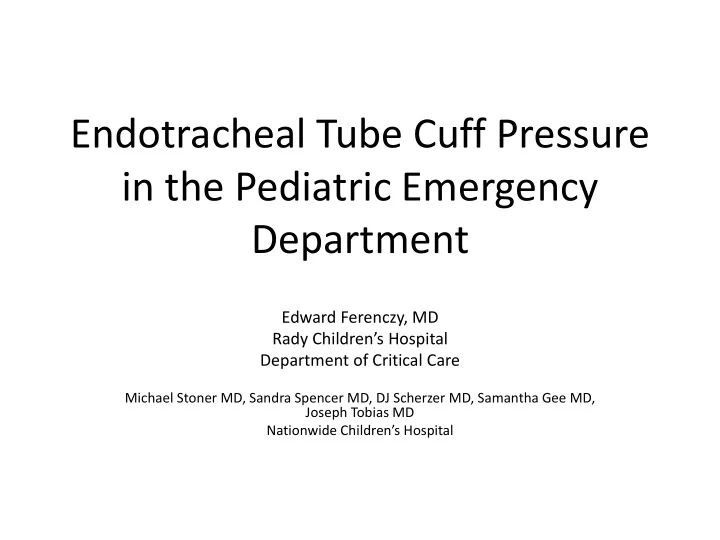

Endotracheal Tube Cuff Pressure in the Pediatric Emergency Department Edward Ferenczy, MD Rady Children’s Hospital Department of Critical Care Michael Stoner MD, Sandra Spencer MD, DJ Scherzer MD, Samantha Gee MD, Joseph Tobias MD Nationwide Children’s Hospital
ETT Cuff pressure in the ED Overview • Question: How many children who are emergently intubated are exposed to a high pressure in their ETT cuff? • Study: Prospective Cohort study • Answer: a little over half
ETT Cuff pressure in the ED What is known? • Cuff pressure can’t be accurately estimated • High ETT cuff pressure is associated with adverse effects • Cuffed ETT use is common in children • Cuffed ETT use is recommended in children
ETT Cuff pressure in the ED The question: • How many children are exposed to a high ETT cuff pressure after emergency intubation? • Do any factors correlate with a high ETT cuff pressure?
ETT Cuff Pressure in the ED Setting: • Emergency Department of an urban, tertiary care pediatric hospital • Level 1 Trauma center • >100,000 Annual visits
ETT Cuff Pressure in the ED Study Design: • Prospective cohort • IRB-approved, informed consent was waived • 12 months of data collection • Data collection performed by certified RT’s
ETT Cuff Pressure in the ED Cohort: • 104 patients enrolled • 42 girls and 62 boys • 10 days to 20 years old • 2.3kg to 102kg • 87 intubations in the study institution emergency department, 7 in the field and 10 at outlying hospitals
Primary Outcome: Cuff Pressure Cuff Pressure in 104 Endotracheally Intubated Children ≥30cmH 2 O: ≤29cmH 2 O: 56% 44% N=58 N=46
Primary Outcome: Cuff Pressure Number of children vs. Cuff pressure groups 45 40 35 Number of Children 30 25 44 20 32 15 10 15 13 5 0 <20cmH 2 O 20-29cmH 2 O 30-60cmH 2 O >60cmH 2 O
Secondary Outcomes What was investigated: • Person performing intubation • Person performing cuff inflation • Endotracheal tube size • Patient age • Patient gender • Patient weight • Diagnostic category (medical or trauma) • Month & time of day
Secondary Outcomes What we found to be statistically significant: • Person performing intubation • Person performing cuff inflation • Endotracheal tube size • Patient age • Patient gender • Patient weight • Diagnostic category (medical or trauma) • Month & time of day
Secondary Outcome: Cuff Inflator OR 3.12, CI 1.1-8.6, p=0.028 Average pressure vs Cuff Inflator 60 Average Cuff Pressure (cmH 2 O ) 50 40 51cmH 2 O 30 33cmH 2 O 20 10 0 Respiratory Therapist All Others
Secondary Outcome: Patient Age OR 2.0, CI 1.3-3.2, p=0.002 Average cuff pressure vs age group 60 Average cuff pressure (cmH 2 O) 50 40 30 45cmH 2 O 37cmH 2 O 24cmH 2 O 20 10 0 < 1 month 1 month - 1 year > 1 year
Secondary Outcome: Patient Weight OR 0.9, CI 0.8-0.97, p=0.007 Average Cuff Pressure vs Weight 60 Average Cuff Pressure (cmH 2 O) 50 54cmH 2 O 40 30 42cmH 2 O 27cmH 2 O 20 10 0 <10kg 10kg-20kg >20kg
ETT Cuff Pressure in the ED What was learned: • Emergently intubated children are likely to be exposed to high ETT cuff pressure • Regular use of a manometer in the ED may help limit exposure to excessive ETT cuff pressure
ETT Cuff Pressure in the ED References: • J Bryant, et al , Can the intracuff pressure be estimated by palpation of the pilot balloon? ICU Director, (2013) 4: 170-172 • Miller MA, et al, A polyurethane cuffed endotracheal tube is associated with decreased rates of ventilator-associated pneumonia. Journal of Critical Care (2011) 26, 280-286 • RD Seegobin, et al, Endotracheal cuff pressure and tracheal mucosal blood flow: endoscopic study of effects of four large volume cuffs, British Medical Journal , (1984) 288: 965-968 • Kleinman ME, et al Part 14: Pediatric advanced life support: 2010 American Heart Association guidelines for cardiopulmonary resuscitation and emergency cardiovascular care. Circulation (122) 2010
ETT Cuff Pressure in the ED Special thanks to: Michael Stoner MD, Sandra Spencer MD & DJ Scherzer MD, Section of Emergency Medicine Nationwide C hildren’s Hospital Samantha Gee MD, Pediatric Critical Care, Nationwide Children’s Hospital Joseph Tobias MD, Anesthesiology and Pain medicine (Chair), Pediatric Critical Care, Nationwide Children’s Hospital
Recommend
More recommend